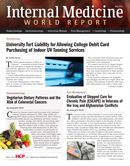Publication
Article
Internal Medicine World Report
Increased Risk of Fractures Associated with Subclinical Thyroid Dysfunction
Author(s):
Overt hyperthyroidism is a known risk factor for osteoporosis and fractures. More subtle alterations in thyroid function, such as those that occur in subclinical thyroid dysfunction, may also be associated with increased fracture risk and bone loss, but until recently no clinical trials have adequately explored that issue.

Overt hyperthyroidism is a known risk factor for osteoporosis and fractures. More subtle alterations in thyroid function, such as those that occur in subclinical thyroid dysfunction, may also be associated with increased fracture risk and bone loss, but until recently no clinical trials have adequately explored that issue.
Now Manuel Blum MD, and colleagues have published a study in JAMA concluding that subclinical hyperthyroidism is associated with an increased risk of hip and other fractures, especially among those with thyroid-stimulating hormone (TSH) levels <0.10 mlU/mL and those with endogenous subclinical hyperthyroidism.
The findings were derived from a pooled analysis of individual participant data from multiple large cohorts assessing the association of subclinical thyroid dysfunction with risk for hip fractures as well as nonspine, clinical spine, and fractures of any location. Blum et al performed a systematic literature search in MEDLINE and EMBASE from inception to March 26, 2015, with no language restriction, for prospective cohorts of adults with baseline TSH and free thyroxine (FT4) levels and follow-up for incident fractures. The primary outcome was hip fracture; other fractures were secondary outcomes.
Individual data were obtained from 13 prospective cohorts in the United States, Japan, Europe, and Australia. Levels of thyroid function were defined as euthyroidism (TSH = 0.45-4.49 mIU/L), subclinical hyperthyroidism (TSH<0.45 mIU/L), and subclinical hypothyroidism (TSH≥ 4.50-19.99 mlU/L) with normal thyroxine concentrations.
Among 70,298 participants, 4092 (5.8%) had subclinical hypothyroidism and 2219 (3.2%) had subclinical hyperthyroidism. During 762,401 person-years of follow-up, hip fractures occurred in 2975 participants (4.6%); any fracture occurred in 2528 participants (9.0%); nonspine fracture in 2018 participants (8.4%), and spine fracture in 296 participants (1.3%).
The hazard ratio (HR) in age- and sex-adjusted analyses for subclinical hyperthyroidism versus euthyroidism was 1.36 for hip fracture; HR for any fracture was 1.28, for nonspine fracture, 1.16; and for spine fracture, 1.51.
Lower TSH was associated with higher fracture rates. For TSH <0.10 mIU/mL, HR was 1.61 for hip fracture; for any fracture, HR was 1.98; for nonspine fracture, HR was 1.61; and HR for spine fracture was 3.57. Risks were similar after adjusting for other fracture risk factors. Endogenous subclinical hyperthyroidism was associated with HRs of 1.52 for hip fracture, 1.42 for any fracture, and 1.74 for spine fracture.
No association was found between subclinical hypothyroidism and fracture risk.
The authors concluded that further study is needed to determine whether treating subclinical hyperthyroidism can prevent fractures.





